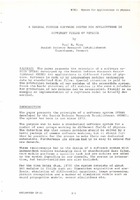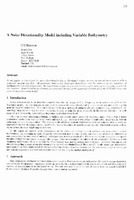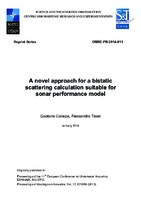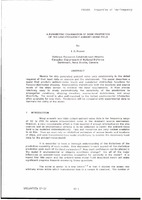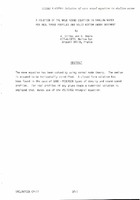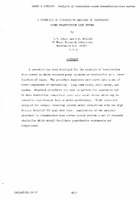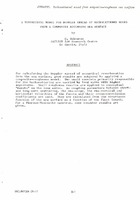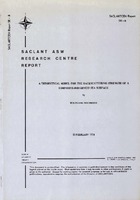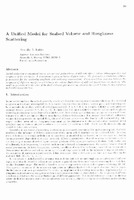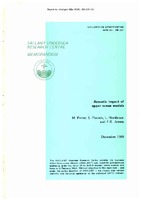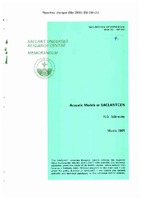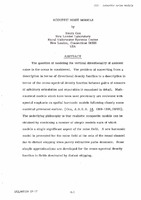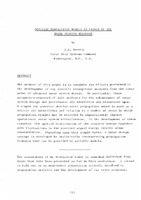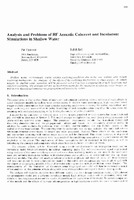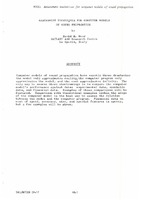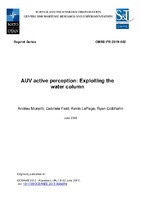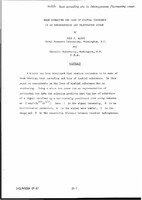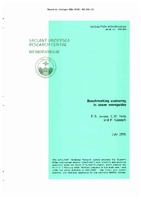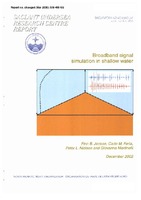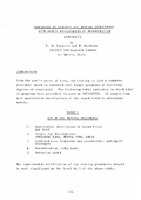Browsing by Subject "Acoustic models"
Now showing items 1-20 of 84
-
A general purpose software system for applications in different fields of physics
(NATO. SACLANTCEN, 1979/12)The paper presents the principle of a software system (FTSS) developed by the Danish Defence Research Establishment (DDRE) for applications in different fields of physics. Software is made up by independent modules exchanging ... -
A noise directionality model including variable bathymetry
(NATO. SACLANTCEN, 1997)In this paper we investigate the noise directionality due to distributed surface sources m several envtronments with a uniformly sloping sea bed. Of particular interest are frequency dependence and the question of the ... -
A novel approach for a bistatic scattering calculation suitable for sonar performance model
(CMRE, 2014/01)One of the classical approaches to the calculation of the sound pressure scattered from a rough surface is to sum the contributions to the field from a set of small tiles that approximate the surface. If the tiles are ... -
A parametric examination of some properties of the low-frequency ambient noise field
(NATO. SACLANTCEN, 1982/06)Models for ship-generated ambient noise vary considerably in the detail required of their input data on sources and the environment. This paper describes a model that predicts ambient-noise levels and cumulative distribution ... -
A solution of of the wave sound equation in shallow water for real speed profiles and solid bottom under sediment
(NATO. SACLANTCEN, 1975/10)The wave equation has been solved by using normal mode theory. The medium is assumed to be horizontally stratified. A closed form solution has been found in the case of GANS - PEDERSEN types of density and sound-speed ... -
A technique of comparative analysis of underwater sound transmission loss curves
(NATO. SACLANTCEN, 1975/10)A procedure has been developed for the analysis of transmission loss curves in which received power is known or expressible as a linear function of range. The procedure separates each curve into a sum of three components ... -
A theoretical model for doppler spread of backscattered sound from a composite roughness sea surface
(NATO. SACLANTCEN, 1975/10)For calculating the Doppler spread of acoustical reverberation from the sea surface, good results are achieved by applying a composite-roughness model. The small wavelets primarily responsible for the backscattering are ... -
A theoretical model for the backscattering strength of a composite roughness sea-surface
(NATO. SACLANTCEN, 1974/02)The surface-backscattering strength is calculated according to Rayleigh theory for surface excursions much smaller than the sound wavelength. By taking into account of self-shadowing and modulation of grazing angles, the ... -
A unified model for seabed volume and roughness scattering
(NATO. SACLANTCEN, 1997)Seabed scattering is considered taking into account perturbations of different type: volume inhomogeneities and roughness of the interfaces. A description is given in terms of plane waves. The first-order perturbation ... -
Acoustic impact of upper ocean models
(NATO. SACLANTCEN, 1989/12)The upper mixed-surface layer of the ocean, with its homogeneous vertical temperature profile, provides a somewhat special acoustic propagation environment where the sound speed will increase (due to pressure) down to the ... -
Acoustic models at SACLANTCEN
(NATO. SACLANTCEN, 1995/03)The Environmental Modelling Group at SACLANTCEN maintains a suite of computer codes to model sound propagation in the ocean. This suite contains numerical models to cover all environmental conditions and acoustic frequencies ... -
Acoustic noise models
(NATO. SACLANTCEN, 1975/10)The question of modeling the vertical directionality of ambient noise in the ocean is considered. The problem of converting from a description in terms of directional density function to a description in terms of the ... -
Acoustic propagation models as viewed by the sonar systems designer
(NATO. SACLANTCEN, 1971/12)The purpose of this paper is to consider the efforts performed in the development of ray acoustic propagation analyses from the viewpoint of advanced sonar system design. In particular, those parameters required of such ... -
Analysis and problems of HF acoustic coherent and incoherent simulations in shallow water
(NATO. SACLANTCEN, 1997)Shallow water environments create complex scattering condit~ons due to the sea surface and bottom scattering mechanisms. An analysis of the effects of the scattering mechan~smso n sonar images of simple targets in shallow ... -
Assessment techniques for computer models of sound propagation
(NATO. SACLANTCEN, 1975/10)Computer models of sound propagation have exactly three drawbacks: the model only approximates reality,the computer program only approximates the model, and the cost approximates infinity. The only way to assess these ... -
AUV active perception: exploiting the water column
(CMRE, 2019/06)Autonomous Underwater Vehicles (AUVs) present a low-cost alternative or supplement to existing underwater surveillance networks. The NATO STO Centre for Maritime Research and Experimentation is developing collaborative ... -
Beam spreading and loss of spatial coherence in an inhomogeneous and fluctuating ocean
(NATO. SACLANTCEN, 1975/10)A theory has been developed that enables estimates to be made of beam bending, beam spreading and loss of spatial coherence. In this paper we concentrate on the loss of spatial coherence due to scattering. Using a minus ... -
Benchmarking scattering in ocean waveguides
(NATO. SACLANTCEN, 1995/07)Accurate numerical solutions are presented for benchmark problems -
Broadband signal simulation in shallow water
(NATO. SACLANTCEN, 2002/12)Today's minimum requirements for ocean acoustic models are to be able to simulate broadband signal transmissions in 2D varying environments with an acceptable computational effort. Standard -
Comparison of CONGRATS ray tracing predictions with MEDUSA measurements of reverberation
(NATO. SACLANTCEN, 1971/12)From the user's point of view, ray tracing is just a computer procedure which is inserted into larger programs of different degrees of complexity . The following table indicates in which kind of programs this procedure is ...
